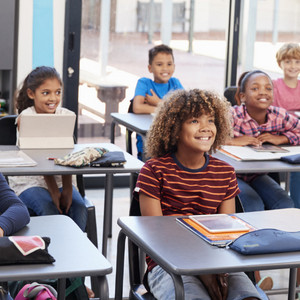Do Seating Arrangements have an Impact on Student Learning?
Now that schools are transitioning back to in-person classrooms, let’s reflect on something we haven’t thought about in a long time: classroom seating arrangements.
Take a look at your class and you will notice that most of the students will choose to occupy the same seat every day. Some prefer to sit at the back, others in front and a few students opt to sit near aisles or close to windows or doors. Is there a reason for their preferences? More importantly, do the seating arrangements affect the learning process?
Influence of seating arrangements on learning
Studies have reported that seating arrangements impact the learning process. Students occupying the front rows are generally more attentive that those in the back. The students in front are the ones who tend to answer questions asked in class.
Classroom arrangement, from a students’ point of view, symbolizes their personality. Often, the diligent, focused students occupy the front rows, in order not to miss out on any vital information whereas the laid back, more casual students opt for the back benches to avoid being noticed by the educators.
Some students report preference for sitting near doors and windows as it provides them with sufficient distractions to escape the monotony of lessons taught. Pranks, whispering, passing of notes, doodling, etc. is most frequent among students who generally sit in the back.
Therefore, seating arrangements may be a cause for a decline of student performance as attention span, concentration, comprehension and the retaining of information can be influenced by where the student chooses to sit.
Enhancing learning through seating arrangements
Teachers can adjust the seating arrangements for learning advantage. Let’s explore some possibilities of creating optimal seating arrangements to advance learning in class.
Row arrangement:
This is the most common arrangement in a class. The room is divided into say three columns, the extreme ends may have two seats each with the center portion having four seats joined together. The number of rows is decided by the strength of the class. This arrangement gives teachers space to walk among and around the students.
This allows educators to utilize the entire space of the classroom while teaching, help students with their work, or adjust movement to make any corrections with ease. Walking between students helps teachers serve as a reminder to students that they are expected to continue working. Supervision and teaching can be made easier with the row method.
Circle arrangement:
When a teacher is conducting discussions, a circular arrangement can be apt to facilitate the flow of ideas, thoughts, and expressions. Students have a clear view of the person expressing their opinions; educators suing a circle seating arrangement find it easy to control the discussion and can motivate passive students to pitch in.
Teachers can arrange the seating of students in such a manner that the active members are seated next to them and more passive students opposite to them. This can enable the teacher to signal to more active participants while providing opportunities to the others, and permits establishment of eye contact with students who may need encourage to participate.
This circular arrangement can help foster group dynamics.
Semi circular arrangement:
A semi-circular seating arrangement can be effective when audio-visual aids, interactive boards, etc. are being used. This ensures clear visibility for every student. Teachers can maintain eye contact with all students and also check to see that they are being attentive. This arrangement can assist in managing the class flow as students are in the open and their actions can be observed.
Round table arrangement:
Planning to give the students some group work? A round table arrangement may be your best option. It encourages students to sit in friendly groups, facilitates free discussion and allows educators to monitor student work. However, the disadvantage is that there is high probability of students misbehaving when the teacher is not looking. For best success, arrange the tables so that the teacher’s table is at the front and the round tables are lined up or arranged in a semi-circle to allow the teacher visibility of all the tables.
Arranged seating vs. free seating
Another important point to consider is whether to assign seats in a seating arrangement or provide students the freedom to select their own spots. Free seating can reinforce cliques within the classroom and students may choose seats that are not conducive to success.
On the other hand, allotment of seats can bring about a certain level of control within the classroom. Pairing of students is done with the hope that they may benefit from each other and also to encourage interactions. A rotation system when integrated into the classroom can ensure that students are not categorized as front or back benchers. Everyone is given an opportunity to sit in the front, middle and back.
Seating arrangements can play a huge role in student performance. Teachers should select an arrangement that best suits their particular circumstances and classes.
Explore more classroom organization strategies with the online continuing ed course: Classroom Organization for the 21st Century.
June 2021 Editor’s Note: This post was originally published in July 2015 and has been updated for accuracy and comprehensiveness.
 About the Author
About the Author
Ellen Paxton is a respected expert in education and best known as the Chief Learning Officer of Professional Learning Board. As a two-time National Board Certified Teacher, Ellen has successfully published and customized online professional development courses and Learning Management Systems for 20 years to help teachers meet their state continuing education renewal credit requirements. Through ProfessionalLearningBoard.com, RenewaTeachingLicense.com, and ConnectedPD.com, Ellen has established solutions and maintained partnerships with several accredited universities, higher education institutions, teachers’ unions and state Departments of Education while setting strategic direction that makes a difference and overseeing implementation of popular online PD for schools.

Comments are closed.